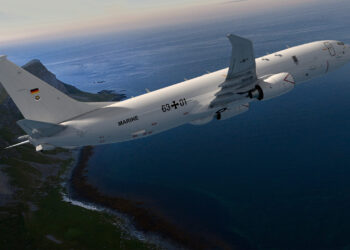Lockheed Martin,
WHITE SANDS, NM: In a successful test of its advanced fire control system, Lockheed Martin's Aegis Open Architecture Weapon System performed a successful missile firing from the U.S. Navy's “USS Desert Ship” at White Sands Missile Range (WSMR).
During the test in early September, the Aegis Fire Control System launched and guided an SM-6 missile Extended Range Active Missile (ERAM) to a successful low-altitude intercept of a target drone. Upon further development of the SM-6 and a new integrated fire control interface, future tests will take on targets beyond the radar line of sight, extending the range at which Aegis-equipped ships can engage air threats.
This test of the latest Aegis Fire Control System and the MK 41 Vertical Launching System (VLS) — installed on the USS Desert Ship, the Navy's land-based, live-fire test bed for surface-to-air weapons — is the second successful test this summer, and follows the Aug. 25 light off of the Aegis Open Architecture Weapon System recently installed on USS Bunker Hill in San Diego.
“The test at White Sands and the success of Aegis Open Architecture in the Navy's Cruiser Modernization Program highlight Aegis' ability to continually leapfrog ahead in capability for the warfighter,” said Orlando Carvalho, vice president and general manager of Lockheed Martin's Surface-Sea Based Missile Defense line of business. “Aegis is the first choice for integrating new missiles, and its open architecture design will integrate new technologies for decades to come.”
Aegis Open Architecture will allow the Navy to stay on technology's leading edge through its innovative use of commonly-available commercial off-the-shelf computing hardware and open system software, enabling the service to more easily implement technology refreshes and capability upgrades to the weapon system as they are developed in the future.
USS Bunker Hill (CG-52) is the first of 22 cruisers scheduled for modernization with Aegis Open Architecture. In 2012, the Navy will begin a similar modernization program for the 62-ship class of Aegis-equipped Arleigh Burke destroyers. All of these ships will be fully capable of launching and supporting SM-6.
The road to Aegis Open Architecture included extensive systems engineering to reconfigure Aegis with commercial off-the-shelf computing hardware and open system software. The end result is a weapon system that can absorb frequent technology refreshes and can readily accept upgrades in capabilities, whether they are accomplished through new development or through the integration of separately developed third party products.
The Aegis Weapon System is the world's premier proven naval defense system and the sea-based element of the U.S. Ballistic Missile Defense System. Its precision S-band SPY-1 radar and missile system seamlessly integrate with its own command and control. Its ability to detect, track and engage targets ranging from sea-skimming cruise missiles to ballistic missiles in space is unmatched.
The 88 Aegis-equipped ships currently in service around the globe have more than 950 years of at-sea operational experience and have launched more than 3,500 missiles in tests and real-world operations. In addition to the U.S., Aegis is the maritime weapon system of choice for Australia, Japan, Norway, South Korea and Spain.
Headquartered in Bethesda, MD, Lockheed Martin employs more than 140,000 people worldwide and is principally engaged in the research, design, development, manufacture, integration and sustainment of advanced technology systems, products and services. The Corporation reported 2007 sales of $41.9 billion.









